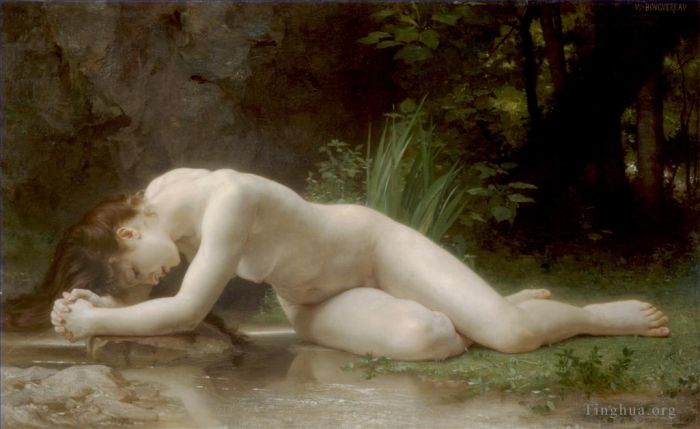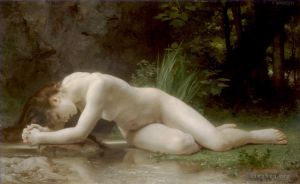Biblis
William-Adolphe Bouguereau
- Price: Price on Request
- Art Type: Oil Painting
- Size:
- English Comments: 0
- International Comments: 0
- Creating Date:
- Introduction and Works of William-Adolphe Bouguereau >>
Keywords:
Biblis
Work Overview
- Biblis
William-Adolphe Bouguereau
Date: c.1884
Style: Neoclassicism
Genre: nude painting (nu)
Media: oil, canvas
Dimensions: 48 x 79 cm
Location: Private Collection
LOT SOLD. 1,025,000 USD
In Greek mythology, Byblis or Bublis (Ancient Greek: Βυβλίς) was a daughter of Miletus. Her mother was either Tragasia, Cyanee, daughter of the river-god Meander, or Eidothea, daughter of King Eurytus of Caria. She fell in love with Caunus, her twin brother.
This impressive painting of Biblis by French artist W.A. Bouguereau records a decisive moment in her life. As the story goes, Biblis, the daughter of Miletus of Crete fell in love with her twin brother Caunus. The painting depicts a moment where Biblis breaks down in grief after Caunus flees from his sister’s affections. Bouguerau employed traditional methods of painting, first doing detailed pencil studies and oil sketches before starting the actual work on canvas. He used mythological themes, painting modern interpretations of classical subjects, with an emphasis on the female human body.
Classical subjects and Greek myths provided Bouguereau with inspiration throughout his career. The resulting narrative paintings were accessible to contemporary audiences and earned him great acclaim as his submissions to the Paris Salon, including compositions such as Nymphs et Satyr (1873, Sterling and Francine Clark Institute, Williamstown Massachusetts), Flore et Zéphyre (1874, Musée de Mulhouse, France), and La Jeunesse de Bacchus (1884, present whereabouts unknown), painted the same year as the present work, which is the réduction of his Salon submission of 1885, Biblis (1884, Salarjung Museum, Hyderabad, India). The classical subject also provided a veil under which Bouguereau could present the nude, a strategy that many Academic artists employed as well.
In Greek mythology, Biblis, daughter of Miletus, fell in love with her twin brother, Caunus. Though she realized that her feelings were taboo, she could not help but try to woo him and sent him a letter citing examples of incest among the Gods. Repelled and afraid, Caunus fled, driving Biblis mad and prompting her to shed her clothes and chase him through Greece and Anatolia, crying incessantly. Exhausted by grief and sorrow, she collapses, perishes and is transformed by nymphs into a spring, or according to other acccounts, is simply consumed by her tears and becomes a fountain. In either outcome, Bouguereau represents Biblis in her penultimate moment.
Bouguereau writes: “Among my paintings, “Biblis” is one that I love the most, one that I most enjoyed painting; this even though it was inspired by an incident in the atelier. One of my female models had just asked to rest from a tiring pose; when the young woman was in the process of standing up, she instinctively found herself in a pose so beautiful that I stopped her with a gesture and a shout, begging her to hold the pose for just an instant longer. I sketched her immediately, very quickly… I had seen my “Biblis.” It is one of my best paintings” (as translated from the French, Vachon, p. 115).
Bouguereau was regularly asked to paint réductions of his most important works, frequently requested by Jules Adolphe Goupil, his exclusive dealer from 1866 onwards, either to provide print-makers with a more manageable-sized canvas to copy (there was a ready market, especially in America, for Bouguereau's prints), or to satisfy the demands of avid collectors wishing to acquire the no-longer-available original.
- Copyright Statement:
All the reproduction of any forms about this work unauthorized by Singing Palette including images, texts and so on will be deemed to be violating the Copyright Laws.
To cite this webpage, please link back here.
- >> English Comments
- >> Chinese Comments
- >> French Comments
- >> German Comments
- >>Report
- Litalienne au tambourin
- Compassion
- Far Niente
- The Return of Spring
- The chilly
- Cupid and Psyche
- Jeune fille allant a la fontaine
- FemmeAuCoquillage 1885
- Jeune italienne puisant de leau
- The Madonna of the Lilies
- The Dance
- Le Baiser 1863
- The Shepherdess
- Reverie
- Girl with bouquet
- Homere et son guide
- The Prisoner
- After the Bath
- Le repos
- Tricoteuse 1879
- Charity
- Jeune ouvriere
- LAmour et Psyche enfants
- Parure des champs
- The Broken Pitcher
- Lady with Glove 1870
- Seated Nude
- Femme Blonde profil 1898
- La tricoteuse
- Adolphe Juene Fille Et Enfant MiCorps
- Portrait de lartiste
- Lidylle
- A Portrait of Leonie
- Idylle 1851
- Etude dune femme pour Offrande a lAmour
- Jeunes bohemiennes
- Le secret
- Le Jeune Bergere 1897
- Soul Carried to Heaven
- Sur la greve
- Temptation 1880
- Maternal Admiration
- The First Mourning
- Le jeune frere 1900
- Unfinished detail
- Sainte Famille
- NotreDame Des Anges
- The Nut Gatherers
- After the Bath
- Madame la Comtesse de Cambaceres
- Madone assise
- Evening Mood (Twilight or Dusk)
- Gabrielle Cot 1890
- Portrait of a Young Girl
- The Birth of Venus
- Cupid with Butterfly
- Work Interrupted
- Une Vocation
- Bohemienne au Tambour de Basque
- Jeune Fille et Enfant
- Etude tete de petite fille tete de petite fille
- Loin du pays
- La Vierge LEnfant Jesus et Saint Jean Baptiste2
- The Mischievous One
- Inspiration
- Le Lever
- Fileuse
- Faneuse
- Washerwomen of Fouesnant 1869
- Paquerettes
- Les Oreades 1902
- Psyche
- Young Woman Contemplating Two Embracing Children
- Boucles DOreilles The earrings 1891
- The Return from the Harvest
- Etude Femme Blondede face 1898
- Study for Vierge aux anges
- TheBather 1879
- Jeunesse Realism angel
- The Virgin with Angels (The Queen of the angels)
- La grappe de raisin
- Marguerite
- La brie du printemps
- La Soupe
- Berceuse
- Brother and Sister
- Au bord du ruisseau
- Psyche et LAmour
- The Nymphaeum
- Vierge consolatrice
- Baigneuse 1870
- Une vocation 1896
- The Youth of Bacchus
- Petite bergere
- A Portrait of Eugene
- Lart et la litterature
- Le Passage du gue
- Un moment repos
- The Heart’s Awakening
- La Charite 1859
- The Madonna of the Roses
- The Young Shepherdess
- Calinerie
- The Storm
- La bourrique oil on canvas
- Branche de laurier
- Le jour (Day)
- La reverence
- Mailice
- Lady Maxwell 1890
- Little beggars
- Avant le bain
- Jeune bergere 1868
- La vague
- Adolphe MAUVAISE ECOLIERE
- La priere
- Le gouter
- Pieta 1876
- Will8iam Dante et Virgile au Enfers
- The Goose Girl 1891
- Linnocence
- La Vierge LEnfant Jesus et Saint Jean Baptiste
- Beaute Romane 1904
- Loves Resistance 1885
- Moissoneuse
- The Motherland (Alma Parens)
- Reve de printemps
- A Portrait of Amelina Dufaud
- Unknown
- The Bohemian
- Portrait of a young girl 1896
- Irene
- Meditation
- The Assault
- Priestess
- La soeur ainee
- Day 1881
- The Shell
- La Vierge a Lagneau
- Bergere
- Orestes Pursued by the Furies
- Tobias Saying Goodbye to his Father 1860
- La lecon difficile
- Douleur damour
- Frere et Soeur
- Le jeune frere
- Bergere 1886
- Laurore
- Le retour du marche
- Petite boudeuse
- Song of the Angels (Virgin of the Angels)
- En penitence
- Le Crab
- La Petite Mendiante
- La soif
- The Shepherdess 1873
- The Invasion
- Petites maraudeuses
- Girl Holding Lemons 1899
- Zenobia Found by Shepherds
- Portrait Of Genevieve Celine Eldest Dau
- Flight of Love
- La Charite Romaine
- Portrait de Mlle Brissac
- Les pommes
- La palme
- Nymphs and Satyr
- Reflexion
- Flagellation of Our Lord Jesus Christ
- Wet Cupid
- The Abduction of Psyche
- The Bathers (The Two Bathers)
- Le jour des morts
- Ladmiration
- Les Jeunes Baigneuses
- Child Braiding A Crown
- Slumber
- The Little Marauder 1900
- The Pastoral Recreation 1868
- Mignon Pensive
- Unknown1
- The Knitting Girl
- Yvonne
- Meditation 1885
- Frere et soeur bretons
- Unfinished
- Biblis
- Portrait Of Madame Olry Roederer
- A Childhood Idyll
- La Gue
- Fardeau agreable
- La jeunesse de Bacchus centre dt
- The Thank Offering
- Jeune fille se defendant contre lamour
- Etude Tete de Jeune fille
- Retour des champs
- Lost Pleiad
- Les prunes
- Portrait de Mademoiselle Elizabeth Gardner
- Amour a laffut angel
- Harvester (The Grape Picker)
- La Comtesse de Montholon
- A la fontaine
- Portrait of a Young Girl Crocheting
- A Portrait of Genevieve
- La couturiere
- Femme de Cervara et Son Enfant 1861
- Modestie
- Deux soeurs
- Drawing of a Woman
- Night
- Mars
- Laurore Realism WilliamAdolphe
- Flagellation of Christ study in pencil
- Study of a Seated Veiled Female Figure









 Singing Palette
Singing Palette